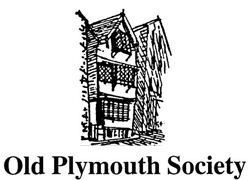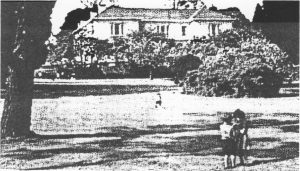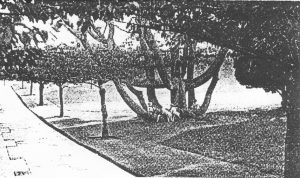by Len Stephens
Published May 2012
Following on from my previous articles on historic houses sited in the northern area of Central Park (then farm fields) I now come to write about the two most important residences, Outlands and Pounds House, built in the early 19th century between Milehouse and Pennycross/Peverell along the Tavistock Road (now called Outland Road).
They were included in the list of gentlemen’s country houses in Brindley’s Directory 1830. Also, Carrington’s Plymouth & Devonport Guide 1835 urged the tourist not to forget to visit the Tything of Pennycross as it contained not only several handsome residences but some of the most delightful scenery in south west Devon. At that time Milehouse was in the country, on the fringe of Pennycross, where the turnpikes from Plymouth to Saltash and Devonport to Tavistock crossed. The quaint tollgate that stood where the entrance to Central Park now stands was known as Milehouse tollgate. At the crossroads there was a thatched inn (the forerunner of the current Britannia) and a smithy which overlooked a hamlet of three farms one of which was Wellesley Farm (which was in existence in the 1930s).
OUTLANDS
It was here in the meadowlands where the Devonport Leat ran that John Ellworth built a country house in 1808 and called it Outlands. Previously the land was part of the manor of Stoches, later Stoke Damerel, and the estate was divided into “plots of lands”, the area at Milehouse being called “9th Land”. The origin of the name Outlands is either “territory on the outskirts of the estate”, or else, as shown in an early tithe map, “the land where oats are the main crop” (although this was probably Oatlands, another house in the area). Outlands changed hands twice before Captain Robert Falcon Scott’s grandfather bought it in 1820 enlarging both the house and gardens. In due course Robert’s parents became owners and on their wedding day planted a Sequoia Gigantea or Wellingtonia sapling in the garden. Robert was born in June 1868 and grew up in the comfortable home of Outlands. The family was fairly wealthy since his grandfather, Robert Scott, had been a Ship’s Purser, retiring in 1826 to purchase the Hoe Gate Street Brewery. Young Robert was baptised at Stoke Damerel church and later became a choirboy at St. Marks in Ford. His childhood was spent at Outlands and it was like living in the country. His parents had a coach and horses and Robert had a pony so rural rides were frequent through the countryside.
Robert Falcon Scott’s naval career started as a cadet at HMS Britannia, Dartmouth in 1881 and during his career he commanded HM Ships Essex and Bulwark. The family home was sold to Joseph Boyd Love on the 27th October 1897. He owned a large drapery at Devonport, called Love’s Emporium, and was an Alderman for the town of Devonport before its amalgamation with Plymouth when he became Alderman for the Pennycross ward. Captain Scott and his family were living in London when he took command of the Discovery and Terra Nova for his Antarctic expeditions.
Before his last fateful journey “down under”, where he died after reaching the South Pole in 1912, he visited Outlands and carved his initials RFS on the tree planted by his parents. The inscribed bark was salvaged when Outlands was demolished after the Second World War to make way for the church and is now in St. Bartholomew’s Church as a memento. Alderman J.B. Love was living in Outlands until April 1941 when two land mines dropped in the grounds severely damaged the front of the house. Three years later it was completely demolished so that the site could be developed for a church, vicarage, and residential home. A plaque was placed on the wall of the church by the Old Plymouth Society to commemorate Captain Scott’s birthplace.
There are not many people today who remember Outlands � my memory of it in the 1930s has had to be refreshed by an article in the Evening Herald of 7th of June 1984 by Muriel Graham for her description of this historic house. She described it as stone built, slate hung and covered with ivy. It backed on to a lane, now Scott Road, with a portion of its wall now incorporated into St. Bartholomew Church grounds. The house was long and narrow with six bedrooms, attics, living rooms, kitchen and cellars. The majority of rooms had garden views. Around it were the orchard, shrubberies, stable and coachman’s house whilst a small reservoir fed by the Devonport Leat passed into a culvert under the lane to reappear in the grounds then disappear behind a grille under Saltash Road.
Now all that survives of its memories are a photograph of the house and the church, the plaque on the wall and names given to nearby streets and the residential home.
POUNDS HOUSE
One of the few surviving Georgian houses of historic importance is Pounds which stands majestically in delightful surroundings in the north-east corner of Central Park. Its potential, I think, is not appreciated by the City authorities who acquired it in 1929 but failed to implement the recommendations of Reuben Mawson’s report on the creation of Central Park.
Let us examine the history of Pounds which was built for William Hodge on land he purchased in 1825, the estate consisting of 60 acres of woodlands in the parish of Pennycross called Pound and Higher Venn and a house called Springfields was previously there. Brindley’s directory of 1830 described it adescribed it as “a neat mansion situated on the road, one mile and a half from Devonport, the property and residence of W. Hodge, Esq. banker”. In an article in the Evening Herald of 20th April 1983, titled “Peverell’s house of history”, Barbara Marlow wrote that Pounds was financed from the fortunes made in banking and commerce by Hodge and his father-in-law William Chapell.
Chapell had traded in timber and hemp for shipbuilding from warehouses in Cumberland Street, Devonport. William Hodge had gone into banking in 1804 with partners William Glencross, who supplied victuals to the Navy, and John Norman. During the 1820s William Hodge expanded his business into shipping and with John Norman prospered in banking aided by the shares left to them on the death of William Glencross. No doubt inspired by his partner John Norman’s building of a country mansion Belmont House in Stoke, William Hodge had Pounds House built on a lavish scale. He was able to obtain the best craftsman in Devonport and much of the building stone was taken from a quarry near the site at the bottom of the now Glendower Road, by the current children’s playground. The house though still attractive has lost much of its period decor due to modernisation, fire and repairs.
The veranda overlooking the park with its distinct five arches has survived; it overlooks the terrace, which originally was graced by elegant statues (I think they were there when I visited Pounds in the 1930s). The vast drawing room and dining room on the ground floor, where huge mirrors hung on the walls must have been the envy of the local gentry and even today receptions are held there. The bedrooms on the first floor had magnificent views, particularly the master bedroom which for several years, until recently, was used as the public lending library, and above it was attic bedrooms where the servants slept.
When John Norman died in 1847 the Devonport Bank became the property of William Hodge and four years later on his death it passed to his son Chapell William Hodge. The Chapell Hodge family became familiar local society figures patronising the Royal Yacht Club and the archery meetings at Manadon. The eldest son William Chapell Hodge married Jane Eliza Buller, daughter of Reverend Richard Buller, vicar of Lanreath, and granddaughter of John Buller, Lord Lieutenant of Cornwall. His father bought Burleigh House nearby for the couple and here was born William Buller Chapell Hodge and his five sisters. With the house came more land adding to that bought from neighbouring landowners and the Pound Estate covered some 500 acres by the end of the 19th century.
William Chapell Hodge died in 1875, he was buried at St. Pancras Church, Pennycross, where lies his tombstone, and Chapell William Hodge succeeded him. In 1891 Devonport extended its boundaries to Pounds’s back door and five years later Plymouth followed; the boundary stones can be seen today outside the garden walls in Venn Lane near the Plymouth Leat stone.
The house began to lose its isolation as Plymouth and Devonport grew and there was a demand for land for building development. When Chapell William Hodge died in 1898 his son William Buller Chapell Hodge who had sought a career in the Army resigned his commission to carry out his father’s instructions in the will that the Pound Estate should be sold by public auction. The estate was conveyed to Messrs. Shellabear, Sheaks and Shellabeare building contractors who immediately sought planning permission to build Peverell Park Road and the housing estate running off the new road from Pounds Park Road in the north to Gifford Terrace in the south, called the Pounds Freehold Building Estate.
That autumn Britain was at war with the Boers in South Africa and William Buller Chapell Hodge re-enlisted and was killed in a Boer commando ambush in November 1900. So ended the four-generation dynasty of Chapell Hodges at Pounds House.
POUNDS HOUSE IN THE 20th CENTURY
George Shellabear decided to keep Pounds House and its Park grounds from development. He lived close by at Welby House and he let Pounds to Sir John Jackson who had come to Devonport to build the Keyham Extension to the Dockyard. Sir John subsequently became Conservative and Unionist MP for Devonport. Sir Clifford Tozer in the 1962 Christmas Cheer recalled that in the General Election at the turn of the century Sir John Jackson canvassed his constituency in, what was rare in Plymouth, an open car instead of a-horse drawn landau. What was more unusual was the colour of the car – bright red – more suited for his opponent John Benn (grandfather of Tony Benn), a radical Liberal.
He defeated Sir John in the 1904 election and again in the Liberal landslide of 1906 but lost the seat in 1910. Sir John Jackson was to remain MP until 1914 when he again lost the seat and he subsequently left Pounds House. During his tenancy the ownership of Pounds changed hands – George Shellabear in 1912 sold it to his son-in-law Henry Hurrell who had married his daughter Lucy and lived nearby at Peverell Park Villa next to Welby.
At the outbreak of the Great War Pounds was untenanted but the grounds and Park were thrown open on many occasions for social gatherings and fetes. Although tentative approaches were made to use the house as a convalescent home it remained unoccupied. The Hurrell’s had removed to their country house during the war years and let their home Peverell Park Villa as an auxiliary rest hospital for wounded officers who were allowed to recuperate in Pounds garden and Park. The house was rarely used in the 1920s and George Shellabear and Henry Hurrell decided to sell it and the grounds to Plymouth Corporation, conveyed on 13th June 1927 for £9,900. So, Pounds House and Park consisting of 18 acres of land were one of three plots sold to Plymouth to form the 241 acres of Central Park – opened in 1931.
Although Mr. J. Dinner was a tenant from 1928 to 1933 the house became sadly neglected and empty. It was even suggested that it should be pulled down and the Plymouth Education Committee proposed that the estate should be developed as a school for Devonport High for Boys to match the new Devonport High School for Girls built on a site opposite Pounds. It never happened and with the advent of the war in 1939 the house was saved for temporarily housing the Town Clerk’s department.
Since the war Pounds has been used in a variety of roles, the most popular being its use as a public library, which ended with the fire on the 7th March 1991. When the house was restored and reopened in September 1992 the library had moved to Hope Baptist Church Hall.
The house is now occupied by the Hearing & Sight Centre, a Victim Support Office, a private caterer for receptions and a weekly Keep fit class. All very laudable uses but is this the best way to operate the last remaining historic house in the area? Perhaps the Museum and Library services, which are so short of space, could put it to better use opening it as a heritage centre to the public. The disused stables which were last used for storing gardening equipment have been carefully converted into Peverell Park Surgery, keeping the building in character with its surroundings. The Plymouth Tourist guidebook, with suitable illustrations, once extolled Pounds Park as a miniature Kew Gardens with an amazing variety of plants and shrubs flowering all the year round. Although in recent years some of its famous -trees have been destroyed by storms or cut down, the Park is
being environmentally developed to become a passive
recreation area along with the eastern side of Central
Park. Pounds has always been enriched by nature
witness the bird life and squirrels which inhabit it and
the bountiful flora.
As we stroll through it and enjoy its beauty, admiring the colourful display of crocus and daffodils in February and March be thankful that we possess in Pounds such an Arcadian retreat from urban life – I am sure its previous owners would have approved our appreciation.


